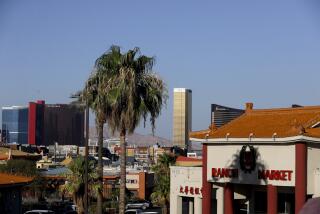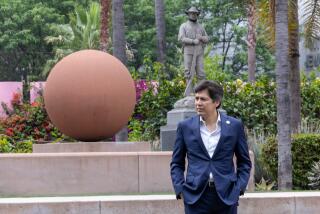Artesia Thinks the World of Itself
- Share via
Jane Martin came all the way from Texas to shop along this four-block avenue of restaurants and stores featuring Indian saris, spices and sweets on Pioneer Boulevard in downtown Artesia. By midday during a visit this week, Martin and her two cousins had already eaten an Indian lunch, purchased Indian fabric and were hunting for Indian soaps to give as Christmas presents.
Even in Houston, Martin said, this area of southeast Los Angeles County is known as Little India.
Maybe so, but it won’t be called that on freeway signs scheduled to be placed soon on the 91 Freeway. After years of controversy, the Artesia City Council has directed Caltrans to designate the area as the Artesia International and Cultural Shopping District.
Council members say their decision is meant to embrace all ethnicities in their downtown area, which also includes Chinese seafood markets, Vietnamese restaurants, Korean beauty salons and a historic Portuguese cultural center.
“How can we sell ourselves short by designating one ethnic identity, when we have such diversity in our city?” Councilwoman Sally Flowers asked. “We’re here to serve everyone.”
Many Indian merchants, however, take a different view.
“It won’t serve anyone’s purpose,” said Dave Kerai, owner of Pioneer Cash & Carry market, who regards the council’s chosen moniker as clumsy and bland. “No one will be happy.”
The Artesia dispute illustrates a classic Southern California struggle over how to negotiate competing claims to a neighborhood’s ethnic identity as it shifts over time. This polyglot region boasts “little” or “town” designations for almost every major ethnic group represented, including Chinatown, Little Tokyo, Little Saigon, Koreatown, Historic Filipinotown, Little Armenia, Little Ethiopia, Thaitown, Little Phnom Penh, Little Tehran and Little Arabia.
Sometimes, neighborhood transitions are smooth. In Los Angeles, for instance, there was “not a peep” of protest over a City Council decision three years ago to designate a historically Jewish stretch of Fairfax Avenue as Little Ethiopia, according to Avak Keotahian, a city legislative analyst. Nor were there objections over similar actions officially recognizing Historic Filipinotown in the south Hollywood area, he said.
Other times, the actions have brought conflict. A few years ago, a move by Filipino merchants to declare a strip of Eagle Rock Boulevard as Philippine Village sparked an uproar -- and a near fistfight -- among the community’s residents. In a 2002 compromise, the L.A. City Council approved a municipal sign in front of the Philippine Village Center in Eagle Rock to recognize its contributions to the local Filipino community.
About five years ago, Armenians and Thais wanted to claim the same stretch of Hollywood Boulevard. The groups eventually compromised; now that stretch, from Western to Normandie avenues, is both Little Armenia and Thaitown, Keotahian said.
Keotahian said such designations often benefit neighborhoods by giving them a distinctive selling point. Indeed, so successful has Little Saigon become as a tourist draw in Orange County that the cities of Westminster and Garden Grove have fought over claiming rights.
“It’s good for business,” Keotahian said. “It brings in tourism. Why would anyone object?”
In Artesia, however, some people did -- vociferously. In what turned into a bitter power struggle between the Artesia area’s state and local officials, Assemblyman Rudy Bermudez (D-Norwalk) won approval last year for Little India directional signs to be placed on the Pioneer Boulevard exits off the 91 Freeway. Bermudez said he acted after requests to do so from the Indian community and because the state had jurisdiction over freeway signs.
But the move provoked outrage from four of the five City Council members, two of whom say Bermudez never consulted with city officials about it. The argument has become nasty at times, with Bermudez publicly accusing opposing council members of bias against Indian Americans. He said his own phone polling and three public meetings on the subject indicated most people either supported the Little India moniker or didn’t care.
“You can make a million and one excuses, but the bottom line is that it’s ethnic bias,” he said of the council’s opposition.
But Artesia Mayor Larry Nelson responded that the issue was local control -- and that Bermudez’s style had destroyed any chance of compromise. “If I try to shove something down your throat, you’ll rebel,” he said. “It’s natural.”
Nelson also said Indian Americans constituted less than 1% of the city’s population, and that East Asian markets outnumber Indian ones 3 to 1.
The council appears to have won the last word on the matter. Just weeks before Bermudez’s Little India resolution passed, the governor signed a bill backed by Artesia officials and written by Assemblyman John Benoit (R-Palm Desert) requiring local approval of proposed freeway sign designations.
Because Artesia officials did not approve the Little India designation -- and in fact vehemently opposed it -- Caltrans does not plan to put that moniker on the freeway signs.
That leaves Artesia with the International and Cultural Shopping District. Councilwoman Flowers said the name fits the town’s new multicultural downtown redevelopment plan. Among other things, the plan envisions placing a lighted globe, flags of various countries and kiosks selling ethnic goods on islands in the middle of Pioneer Boulevard.
Some of the Indian merchants have bought into the vision. Dhanesh K. Bhindi, for instance, is developing a new shopping center a few blocks from his Bhindi Jewellers, frequented by the likes of Madonna. In keeping with the city’s theme, he said, he planned to name the center Bhindi’s International Crossroads.
“I foresee the occupancy to be international businesses, not just of one ethnicity, because I feel that’s what this area is all about,” said Bhindi, a native of the Fiji Islands who came to Artesia in 1984.
Kerai, the market owner, said he had hoped for something more distinctive. As president of the Chamber of Commerce last year, he proposed a compromise to put “Little India Shopping District” on the sign. That, he said, could call attention to the unique cluster of Indian shops on Pioneer Boulevard without implying that the entire city was Indian.
Meanwhile, at least one exasperated merchant has simply gone his own way.
Venkatesh Koka is the developer of the Little India Village shopping plaza and an avid promoter of the Little India freeway signs. Rather than wait for the city to come around, he has managed to plaster his father’s name and family business -- “Krishna Koka’s Little India Village” -- on four roadside signs along the 91 and 605 freeways around Artesia.
How? Through the state’s Adopt-A-Highway program, under which those who help tidy up roadways can be recognized for it. Koka said he paid $1,000 a month for a maintenance service to clean the four stretches of freeway.
“This is the way to beat them,” he said of Artesia city officials. “If they won’t put up a sign, we’ll put up ours.”
More to Read
Sign up for Essential California
The most important California stories and recommendations in your inbox every morning.
You may occasionally receive promotional content from the Los Angeles Times.











